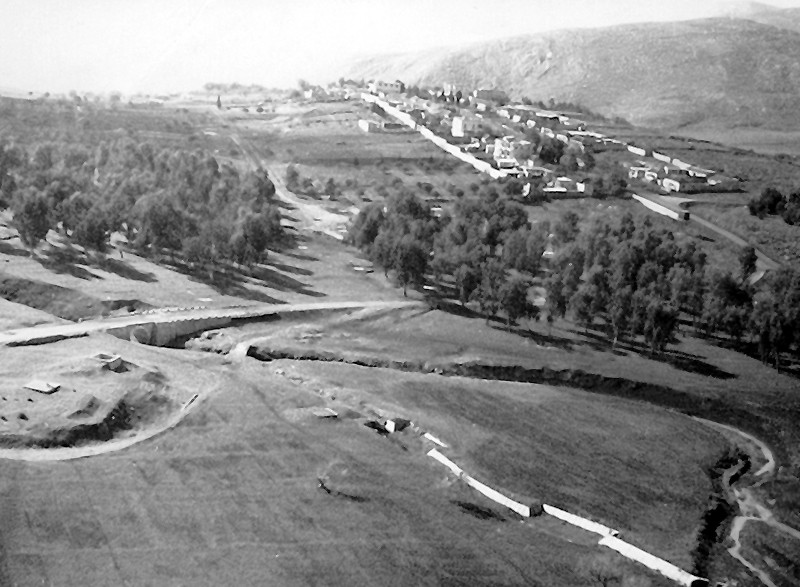Preparations for Operation "Markolet" ('Night of the Bridges')
The 'Night of the Bridges' (operation "Markolet") sent the Palmach on a bombing mission of all bridges connecting western Israel with its neighboring countries, excluding three passes the political leadership forbade to bomb: The Ras En Naqura tunnel, and the Jordan and Yarmuk bridges that led to the power factory in Naharayim.
The 'Night of the Bridges' (operation "Markolet") sent the Palmach on a bombing mission of all bridges connecting western Israel with its neighboring countries, excluding three passes the political leadership forbade to bomb: The Ras En Naqura tunnel, and the Jordan and Yarmuk bridges that led to the power factory in Naharayim. Yigal Alon, commander of the Palmach, conceived the idea of bombing the bridges, and the Palmach Operations officer, Dov Zesis, planned it. Forces from four of the Palmach's battalions participated in the bridge attacks and diversion tactic that followed. At that time, Uri Yafe commanded the 1st Battalion, Ze'ev Glazer commanded the 2nd Battalion, Shalom Chavlin commanded the 3rd Battalion and Nachum Sarig commanded the 4th Battalion.
The preparations for the operation started as early as January-February 1946, with the participation of the 'Hagana Intelligence Service' ('Shai'), Palmach patrols and crews from forces destined to perform the operation. They prepared target files, did day and night scouting (disguised as geography trips or couples' romantic getaways in nature), inspected access and escape routes and obtained the structure plans of the bridges from the P.W.D to enable a precise placement of the explosives. In addition, they photographed and measured the targets in the field. The forces were briefed based on information gathered during the preparation activities and exercised the raids.
According to the original plan, the operation was scheduled for May, but was postponed for political reasons (awaiting the British position on the Anglo-American inquiry commission.) Eventually, the operation took place on the night of the 16th to the 17th of June 1946.
Due to its scope and complexity, the mission demanded:
Punctuality; planning of the attack and retreat from the target; preparation for a lengthy movement on foot, as well as lengthy stay in the field after the raid – so as not to expose Jewish settlements in the area; planning that would obey the commandership order to prevent bloodshed; a comprehensive logistical coordination and supply of equipment to the various forces, chief and secondary, of unprecedented amounts; preparing considerable amounts of explosives for sabotaging the bridges; a precise planning of the placement of the explosives to achieve the desired result as it is stipulated in the operation order: To render the bridges impassable and make them appear destructed; proper teaming of a relatively large number of forces, both for the bridge attack and for the diversion tactics; matching the size of the force to the complexity of the operation: Missions involving significant physical effort due to distance and required explosives amount, demanded a large number of warriors. However, a smaller number of warriors were assigned to bridges nearby Jewish settlements, so that they would easily blend in with the environment with no problems upon completion of the operation; preparing special solutions based on the specific problems discovered in each bridge.
The preparations for the operation started as early as January-February 1946, with the participation of the 'Hagana Intelligence Service' ('Shai'), Palmach patrols and crews from forces destined to perform the operation. They prepared target files, did day and night scouting (disguised as geography trips or couples' romantic getaways in nature), inspected access and escape routes and obtained the structure plans of the bridges from the P.W.D to enable a precise placement of the explosives. In addition, they photographed and measured the targets in the field. The forces were briefed based on information gathered during the preparation activities and exercised the raids.
According to the original plan, the operation was scheduled for May, but was postponed for political reasons (awaiting the British position on the Anglo-American inquiry commission.) Eventually, the operation took place on the night of the 16th to the 17th of June 1946.
Due to its scope and complexity, the mission demanded:
Punctuality; planning of the attack and retreat from the target; preparation for a lengthy movement on foot, as well as lengthy stay in the field after the raid – so as not to expose Jewish settlements in the area; planning that would obey the commandership order to prevent bloodshed; a comprehensive logistical coordination and supply of equipment to the various forces, chief and secondary, of unprecedented amounts; preparing considerable amounts of explosives for sabotaging the bridges; a precise planning of the placement of the explosives to achieve the desired result as it is stipulated in the operation order: To render the bridges impassable and make them appear destructed; proper teaming of a relatively large number of forces, both for the bridge attack and for the diversion tactics; matching the size of the force to the complexity of the operation: Missions involving significant physical effort due to distance and required explosives amount, demanded a large number of warriors. However, a smaller number of warriors were assigned to bridges nearby Jewish settlements, so that they would easily blend in with the environment with no problems upon completion of the operation; preparing special solutions based on the specific problems discovered in each bridge.
















